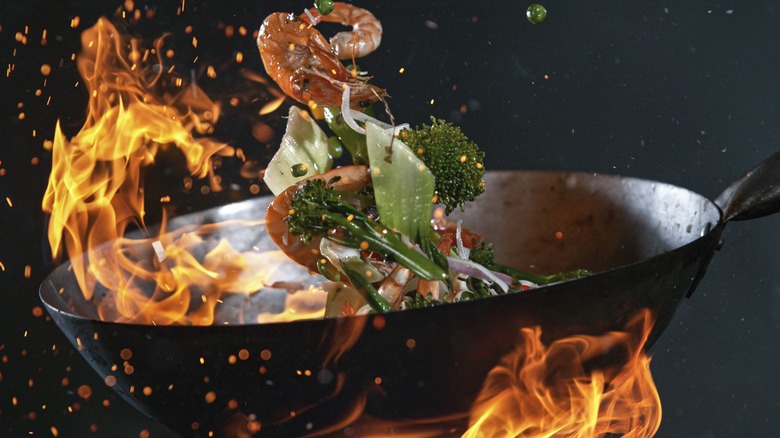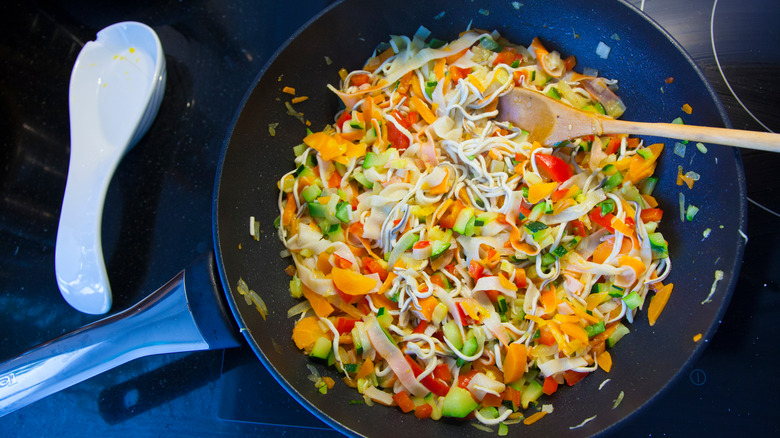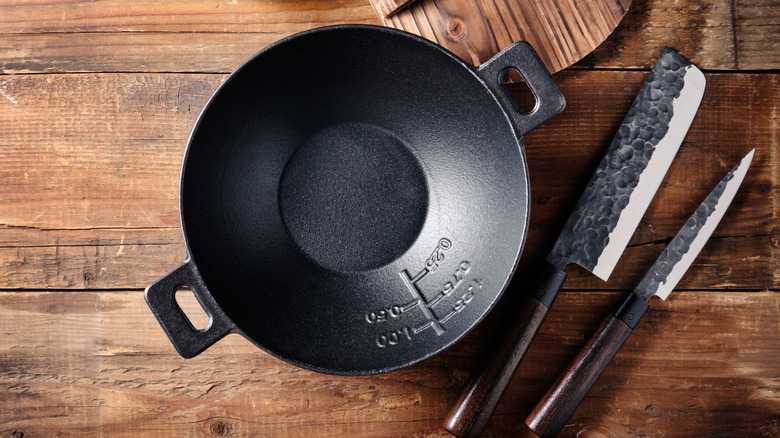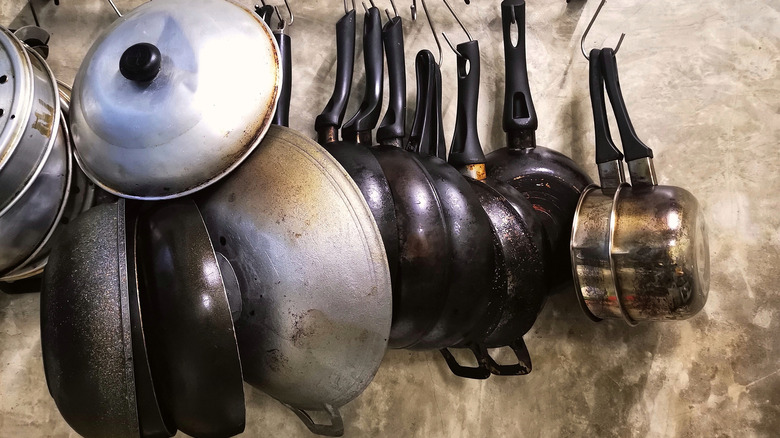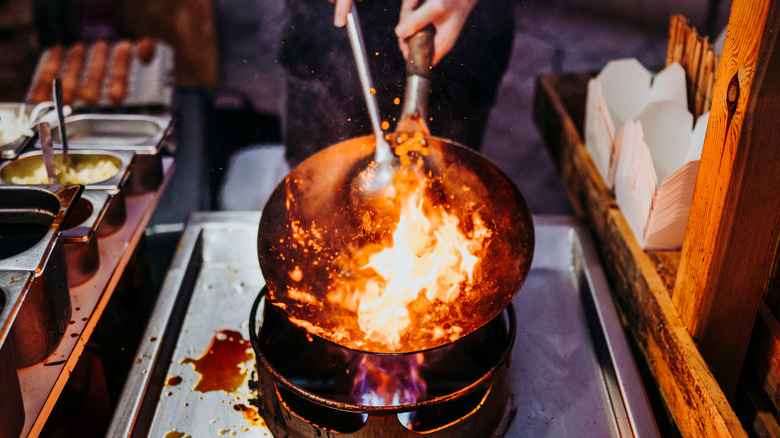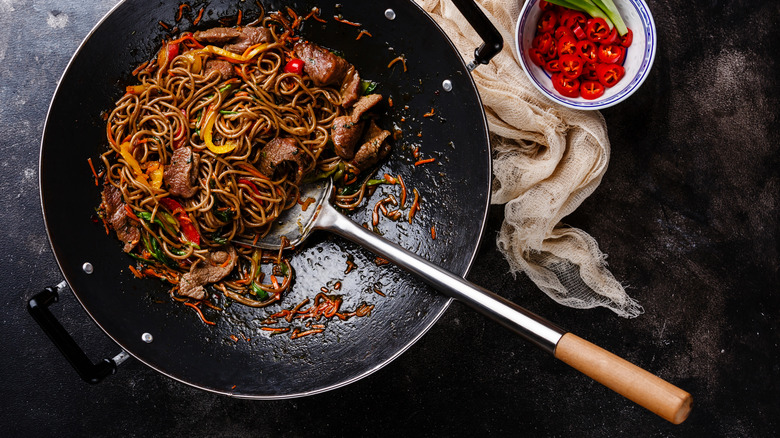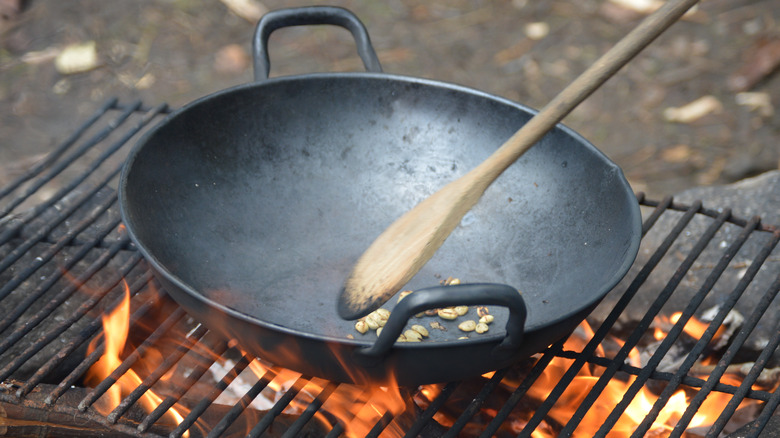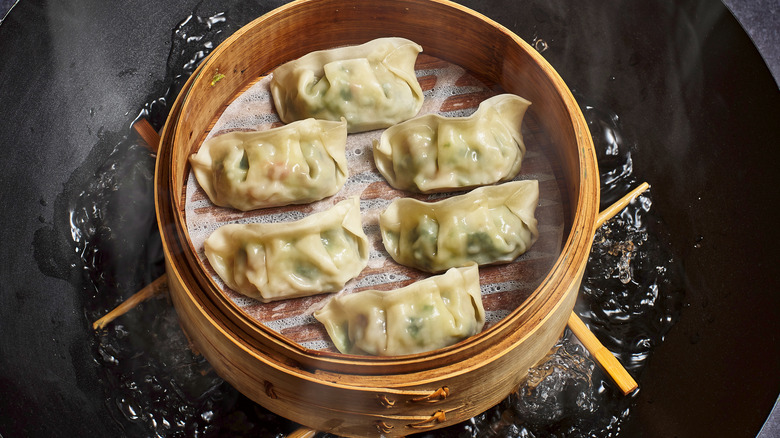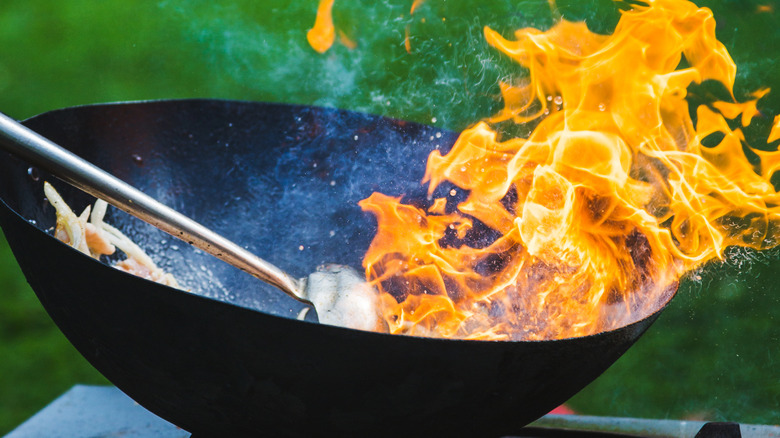Common Mistakes Everyone Makes With Their Wok
Buying new equipment for your kitchen leads to a special kind of excitement unmatched by other purchases. Whether a sauteuse, frying pan, or Dutch oven, clutching one of these brand-new vessels leads your imagination to run wild with culinary possibilities. But few are as exhilarating as a wok. On your way home you can already imagine yourself deftly handling the pan, charred veggies flipping through flames and steam, your family awestruck by your skill. It's going to be perfect.
But just like the other pans that adorn your kitchen shelves, not all woks are built equally. A wok can be one of the most versatile instruments in your cooking toolkit, but it can also be easily misused and ill cared-for. Before you crank up the flames, you need to consider a few important features as well as how you plan on using it. Here are a few common missteps to avoid in order to get the most out of your wok experience.
Buying the wrong pan for your stovetop
Often when we see a wok in action at a restaurant, the rounded bottom shape is what stands out. So, naturally, when looking for a wok to purchase, it's easy to gravitate toward the models that look the most similar. But before you tap your card to purchase, consider the heating element on which you'll be using it. In restaurants, woks tend to be used over high heat and an open flame, usually sitting on a grate that can accommodate the round bottom of the pan. Will you be cooking over an open flame outside or on a stove inside? Is your stove electric or gas?
If it's electric, is the surface a flat glass top or are there grates? If it's a flat top, opt for a wok with a flat bottom so it can rest easily on the heating surface. Electric stoves tend to heat up slower than gas, so consider a wok that is made of a material that holds onto heat, with enameled cast iron or stainless steel with an aluminum core to distribute heat evenly (via chefpangcake).
If you are cooking over an open flame, like an outdoor grill or on a gas stove, think about opting for the more traditional round-bottom wok. Bob Vila explains that the round bottom is resistant to warping under the stress of intense heat, making it ideal for the rapid and intense stir-frying over fire. Be aware that, due to the shape, you have to be holding and maneuvering the pan the entire time it is in use, but that's a small issue because the cooking time will be relatively quick.
Buying a wok that is too big
A common mistake when purchasing a wok is picking one that is entirely too big. Again, we might owe this to seeing industry professionals easily whipping up large portions in a 16-inch flying saucer. But at home, you may have a different audience. After you consider what kind of stove you're working with and you choose the right shape for your cooking surface, think about how many people you'll likely be feeding.
Wokware shows us, with a helpful chart, that most woks describe their capacity in quarts and how that translates to serving size. Maybe you live alone and occasionally entertain, so a smaller 5-quart wok, which is roughly 12 inches and holds up to two to three servings, is enough. For a family of six, check out an 8-quart wok that's around 14 inches and holds enough for seven or eight servings. Any bigger than that and you'll want to measure the base of the wok to see if it matches the size of the burner on your stove. If the base is larger than the heating element, you'll risk uneven heating in the area that is designed to be the hottest part of the pan.
Choosing the wrong material
From cast iron to ceramic-lined and Teflon-coated, woks are being produced from scores of materials, each claiming to be the best for you. According to The Woks of Life, many first-time users gravitate toward Teflon-coated woks. The allure is that seasoning the wok is completely unnecessary, and the coating also makes for easy cleanup. So what's not to love?
Well, unlike some other pans, woks are commonly used over extremely high heat and this can damage the coating while possibly releasing properties of the coating into your food. Furthermore, it's very difficult to achieve "wok hei" with a Teflon wok. Wok hei, according to Michelin Guide, is that indescribable quality of expertly cooked stir fry. Most easily described as smoky, charred edges, it directly translates to "breath of a wok." Wok hei is achieved with intense heat and often by the food interacting directly with the flames.
The materials that best handle cooking temperatures like this are carbon steel and cast iron. Both are reliable materials for woks, have been used in traditional Chinese cooking, and require seasoning beforehand. Carbon steel is often the most recommended because it has the benefit of being lighter than most cast iron and is not in danger of rusting.
Not using a wok ring
The completely round wok shape is what makes it effective and unique compared to all of the other cooking pans, but it also makes it a bit unstable. Even the flat-bottomed ones can become unwieldy and top heavy when maneuvered, simply due to the significant change in diameter from top to base. The easy solution is to use a wok ring.
A wok ring is a raised hoop made of metal and is designed to sit on top of the heating element, creating a comfortable seat for the base of your wok to sit in while also allowing for smooth tilting and handling of the pan. There are different wok rings that will work with your electric or gas stove, so think about an aluminum wok ring rather than a cast-iron ring if you have a glass surface that you want to avoid scratching. As Wokware explains, wok rings are excellent for increasing stability and concentrating heat toward the bottom of the pan over open flames. In the case of electric stoves, however, be aware that the ring also creates some distance between the heat source and the bottom of the pan. This pocket of space could be counter-productive for an electric stove that doesn't produce as much heat in the first place.
Using the wrong spatula
Although selecting the right wok material, shape, and size is the priority, once you've made that step, it's time to accessorize! We're speaking of kitchen utensils, of course. One tool that will be invaluable to your stir frying is the wok chuan. Sure, you could use a wooden spoon or a different plastic spatula in your arsenal, but none is as perfectly suited to the wok's unique shape and demands than the wok chuan.
Wok cooking has specific needs. Usually you are cooking over high heat, moving the contents of the pan feverishly and constantly, and the curved construction of the wok makes straight-edged utensils less effective. As The Kitchn details, the wok chuan is a spatula with a flat shape but a curved edge, raised walls, and a long handle. Each feature serves a purpose to make your stir frying absolutely shine. The flat and wide surface allows you to move more ingredients around quickly, the raised walls can function for scooping and serving the finished dish, the curved edge ensures every part of the wok is accessible, and the long handle keeps your hands safe from the 650-degree F heat.
Make sure the material of your wok chuan matches the surface of your wok. As the Foods Guy notes, a metal wok chuan will work best with a more traditional carbon steel wok, but will scratch any Teflon variety. In this case, it's best to choose one made of silicone or wood.
Not seasoning your wok
One point of anxiety for cast-iron and carbon-steel wok owners is how to season the pan. How do you do it? Do you even need to? Did you ruin it? Yes, you absolutely need to do it. After you accept that truth, put your worries aside. Seasoning is necessary to create a non-stick surface for your cookware, in addition to sealing off any intruding water that may lead to rust.
Properly seasoning your wok will ensure that this quality piece of kitchen equipment lasts for decades and, in some cases, generations. Although the initial stages might be a little stinky, since you have to cook off some of that factory smell, Food52 lays out an easy-to-follow process to build a striking and effective coating on your wok. Note that discoloration is not only inevitable but a good sign. Over the course of a year of regular use, your carbon-steel wok will go from mottled to yellowed until it reaches a solid, jet-black patina. This is a well-seasoned wok.
Not going beyond stir frying
One common misconception is that woks are reserved for stir frying only. While you should definitely be stir frying in your wok, you'll be happy to know that you can actually grab that pan for many more meals! Due to its deep, wide shape, woks are excellent for multiple styles of cooking.
As Foodal explains, the tapered belly of the pan is perfect for steaming and deep frying. When steaming food with a bamboo steamer or metal steamer basket, the water sits in the bottom and the insert will rest a comfortable distance above. For deep frying, the tapered belly again aids in the process. Only about two inches of oil is necessary, and since the vessel is bowl shaped, you will end up using less oil than in a cylindrical pot. Maintaining the temperature of a cast-iron wok will also be easier when adding cold foods to the hot oil.
Serious Eats examines the benefits of wok-braising foods. When braising saucy dishes that contain delicate ingredients like silken tofu or vegetables that are softening, the wok is the only vessel that allows you to stir without plunging a spoon or a spatula inside. The gently sloping sides are perfect for swirling and tossing the contents gently, easily avoiding accidental damage to fragile foods.
Cooking at the wrong temperature
Now that you're ready to tackle multiple types of cooking in your wok, it's important to recognize that different styles require different cooking temperatures. One of the most common foibles of wok cooking at home is that many folks end up frequently steaming the contents. Using the wrong pan for your stove, the wrong material, size, and other factors can all lead to the pan simply not being hot enough. Compound that with adding cold ingredients or overcrowding your pan, and you're no longer frying.
Serious Eats emphasizes the importance of high-heat input for stir frying. Stir frying requires temperatures of around 650 degrees F to be applied for nearly the entire cooking time, and especially to achieve wok hei. For steaming or braising, it's okay to take your foot off the gas. Temperatures closer to 212 degrees F — and covering your wok with a lid — are ideal for the gentle cooking of vegetables or dumplings. As Fine Cooking recommends, bring your water to a boil first and then add your ingredients for steaming.
